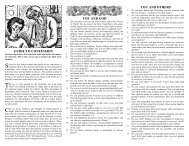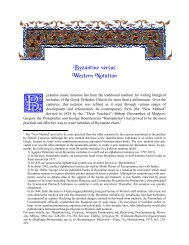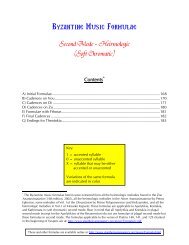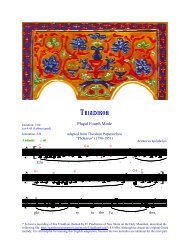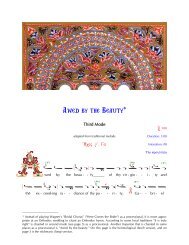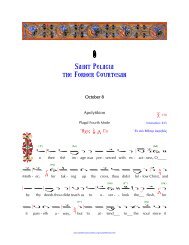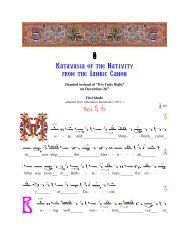Reading Psalmodia (PDF) - St. Anthony's Monastery
Reading Psalmodia (PDF) - St. Anthony's Monastery
Reading Psalmodia (PDF) - St. Anthony's Monastery
Create successful ePaper yourself
Turn your PDF publications into a flip-book with our unique Google optimized e-Paper software.
In order to be able to identify and discuss the notes of the chant, we need a way ofidentifying them. Syllables are used to name each note, just as the syllables "doh" "re""mi" are often used to name the successive notes of the scale in European music. Thesyllables used in Byzantine chant are as follows:Ni Pa Vu Ga Di Ke Zo NiIf we are singing the diatonic scale, they correspond toDo Re Mi Fa So La Si Do[Ni Pa Vu Ga Di Ke Zo Ni’]Church music is normally written within a compass of two octaves from low di (So) tothe high Di' (So) fifteen notes above. The Middle of this, from Ni to Ni' is the mostcommonly used part of the range. In transcribing the chant, we shall read the lower Nias corresponding to the note C - the Middle C of the piano for women's voices, the C anoctave lower for men's. (This is slightly sharper than the tuning laid down by the Patriarchalauthorities in 1881 [Ni = 512], but is convenient for purposes of transcription. In any case, theprecise pitch laid down by the Patriarchal authorities had little justification beyond the generallate nineteenth century obsession with the exact mathematical analysis of musical pitches andintervals.)If, then, we sing an ascending diatonic scale starting from C, the psaltic syllables willcorrespond to the notes of the scale as follows:Ni Pa Vu Ga Di Ke Zo NiC D E F G A B C.2. THE TYPES of SCALE:<strong>Psalmodia</strong> uses four main types of scale, Diatonic, Hard Chromatic, Soft Chromaticand Enharmonic.The way we hear the scales used in modern European music has been greatly affectedby the "Even Temperament" system of instrumental tuning, so that we hear the whitenote scale C to C on the piano as a diatonic major scale. A well-trained psaltes hears thatscale as something subtly different, as approximating to the Enharmonic scale on Ni.The Enharmonic scales of <strong>Psalmodia</strong> are sung to approximately the same tuning as thecorresponding piano scale: i.e. the steps of the scale makes use of only two kinds ofinterval, Enharmonic Tones and Enharmonic semitones, the tones being exactly doublethe size of Enharmonic Semitones.The octave is divided by psaltic theorists into 72 micro-steps - for simplicity let us callthem "steplets." The steps of the Enharmonic scale can be defined very easily in terms ofthe number of steplets to each step. Let us take the Enharmonic scale on F (Ga) as anexample:F G A B b C D E F| 12 | 12 | 6 | 12 | 12 | 12 | 6 |Ga Di Ke Zo Ni Pa Vu Ga'6





